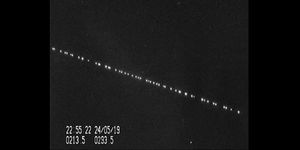How Cas13 Works in Bacteria
In recent years, significant advancements in genetic research, diagnostic tools, and therapies have been made possible by researchers who took advantage of features of the bacterial immune system. The Cas enzymes are a group of proteins used by bacteria in their fight against viruses. The one researchers know the most about right now is Cas9, which is commonly used in the CRISPR gene editing technique in the lab as well as in some experimental human therapies. The Cas enzymes are able to make cuts in DNA as well as RNA - the genetic material of other organisms. Now scientists have learned more about Cas13, which was discovered in 2015. Current uses for the enzyme are described in the video.
Viruses that infect bacteria are called bacteriophages or phages. "Since Cas13 targets RNA, it was initially thought to have evolved to impede phages with RNA genomes. The problem is, RNA phages are exceedingly rare," said molecular biologist Luciano Marraffini, a Howard Hughes Medical Institute investigator at the Rockefeller University. "So we wanted to see whether it might have evolved to serve a different function."
The new findings demonstrate that in bacteria, Cas13 targets invading viruses. But Cas13 also modifies the bacterium as well, triggering it to enter a dormant state in which viruses cannot replicate. This strategy can shield bacterial colonies from viruses that slip by other bacterial immune defenses. The work was reported in Nature.
While the Cas9 enzyme can be guided to cut in specific places in the genome, it can make cuts in unintended places as well. There are ways to reduce those off-target effects. But Cas13 makes far more unintended cuts, and since it not only targets DNA but also RNA, researchers have been able to use it for different purposes than Cas9.
“Cas13 has already become a very powerful diagnostic tool,” explained study coauthor Alexander Meeske, also at Rockefeller. It has enabled the rapid detection of viruses in blood samples, even when very little virus is present. “What we didn't know, is how Cas13’s behavior affects bacterial immunity,” he added.
In the ongoing molecular arms race between bacteria and viruses, viruses have developed ways to get around the Cas enzymes. If a mutation occurs in the genetic sequence that Cas targets, a virus may remain undetected. While it seems like Cas13 is just slashing any and all RNA at random, this is an important strategy for the microbe, the researchers discovered. Many Cas enzymes stop viruses from continuing to reproduce, but Cas13's actions also disable the host microbe. That means that mutant viruses that have slipped by other Cas enzymes can get caught by Cas13.
Cas13 makes many cuts in RNA, cutting both RNA made by for the virus and for the bacterial host. But since a virus can't replicate even when Cas13 cuts only disposable viral RNA sequences, the scientists hypothesized that the bacterial cell was also stopping the virus from reproducing.
The investigators engineered viruses that Cas13 could not detect, and they thrived in Listeria bacteria. When the bacteria were exposed to unmutated viruses along with the mutated viruses, the cells were protected from infection. Cas13 was switched on, and it began to chop up the cell’s RNA. The microbes were unable to function or grow without RNA, but if the cell isn’t working, the virus can’t replicate either.
Right now, it’s unclear whether bacteria can recover after entering a dormant state, or if they eventually die, Meeske added. The microbial cells do, however, protect the surrounding population by preventing the viruses from replicating.
Learn more about how researchers at the Broad Institute are using Cas13 to develop diagnostic tools from the video.
Sources: HHMI, Rockefeller University, Nature








